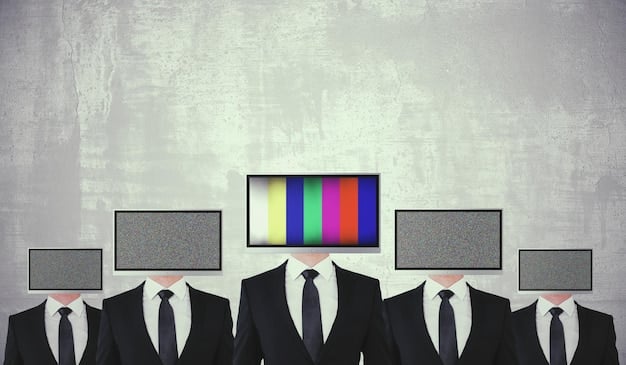Unveiling Media Bias: How News Sources Frame Political Issues

News sources often frame political issues differently based on their perspectives and target audience, which can significantly influence public opinion and political discourse. Understanding these frames is crucial for informed citizenship and mitigating the effects of media bias.
In today’s media landscape, understanding how do different news sources frame political issues? A comparative analysis of media bias is more critical than ever. This article delves into the subtle yet powerful ways news outlets shape narratives, influence public opinion, and contribute to a polarized political discourse.
Understanding the Concept of Framing in News
Framing, in the context of news, refers to the way media outlets structure and present information. This includes selecting certain aspects of a story, prioritizing some facts over others, and using specific language to influence how the audience understands and interprets an event. It’s a powerful tool that shapes public perception and political debate.
The Role of Selective Reporting
One key aspect of framing is selective reporting. News outlets choose which stories to cover and which to ignore. This selection process can significantly impact the audience’s understanding of important issues. For example, a news source might focus heavily on one economic indicator while downplaying others, creating a skewed view of the overall economic health.
Framing also involves the use of language. Words carry connotations and emotional weight. By choosing specific terms to describe events, people, or policies, news outlets can subtly influence how the audience feels about them. For example, describing a government program as “welfare” versus “assistance for the needy” can evoke very different reactions.
- Selective reporting highlights certain facts.
- Language shapes emotional responses.
- Framing influences overall interpretation.
Framing isn’t inherently malicious. It’s a natural part of the storytelling process. However, when framing is used deliberately to promote a particular agenda or distort the truth, it can have negative consequences. It can contribute to political polarization, erode trust in the media, and make it more difficult for the public to make informed decisions.
In essence, framing is the lens through which news is presented. By understanding how this lens works, readers can become more critical consumers of information and better equipped to navigate the complex world of political news.
Identifying Bias in Different News Outlets
Identifying bias in news outlets is a crucial skill for anyone seeking to be well-informed. No news source is entirely objective; all have their own perspectives and biases, whether conscious or unconscious. Recognizing these biases allows individuals to critically evaluate the information they receive and form their own informed opinions.

One common form of bias is partisan bias, where a news outlet consistently favors one political party or ideology over others. This bias can manifest in several ways, including the selection of stories, the framing of issues, and the tone of coverage. Partisan news sources often present information in a way that supports their preferred party and attacks their opponents.
Another type of bias is corporate bias, which occurs when news outlets are influenced by their corporate owners or advertisers. This can lead to a reluctance to cover stories that might harm the company’s interests or those of its sponsors. Corporate bias can be subtle, but it can have a significant impact on the types of stories that are covered and how they are presented.
Recognizing Different Forms of Bias
Beyond partisan and corporate bias, there are other forms of bias that can affect news coverage. These include:
- Bias by omission: Leaving out important facts.
- Bias by spin: Presenting information in a subjective manner.
- Bias by source control: Relying on sources with a vested interest.
To identify bias, it’s essential to compare coverage of the same event across multiple news sources. Look for differences in the facts that are emphasized, the language that is used, and the overall tone of the coverage. Pay attention to who is quoted and what perspectives are included or excluded. Be wary of news sources that consistently present one side of an issue and demonize opposing viewpoints.
Ultimately, becoming a critical consumer of news requires a willingness to challenge your own assumptions and seek out diverse perspectives. By understanding the different types of bias and actively seeking out multiple sources of information, individuals can develop a more nuanced and informed understanding of political issues.
Case Studies: Comparing Coverage of a Specific Political Issue
Examining how different news outlets cover the same political issue provides valuable insights into their underlying biases and framing strategies. By comparing and contrasting their coverage, readers can gain a deeper understanding of the issue and develop a more informed perspective.
Consider, for example, the coverage of a proposed tax reform. A left-leaning news source might focus on how the reform would benefit the wealthy at the expense of the poor and middle class. They might highlight statistics showing the increased income inequality that would result from the reform and quote experts who criticize its fairness. A right-leaning news source, on the other hand, might emphasize how the reform would stimulate economic growth and create jobs. They might focus on the potential benefits for businesses and investors and quote economists who support the reform.

Analyzing the Language Used
The language used by different news outlets can also reveal their biases. For example, a news source that favors stricter immigration policies might use terms like “illegal aliens” or “border crisis” to describe the situation on the border. A news source that supports more lenient policies might use terms like “undocumented immigrants” or “humanitarian crisis.” The choice of words can significantly influence how the audience perceives the issue.
- Left-leaning sources focus on social justice.
- Right-leaning sources highlight economic growth.
- Language strongly influences perception.
Another area to examine is the sources that news outlets rely on. Do they primarily quote experts who share their own political views? Do they give equal time to opposing perspectives? Are they transparent about the affiliations of their sources? The answers to these questions can provide clues about the news outlet’s biases.
By carefully analyzing the coverage of a specific political issue across multiple news sources, readers can uncover the different frames being used and assess the biases that may be influencing the reporting. This critical analysis is essential for developing a well-rounded and informed understanding of complex political issues.
The Impact of Media Framing on Public Opinion
Media framing has a profound impact on public opinion. The way news outlets frame issues can shape how people understand them, what they believe about them, and how they feel about them. This influence can extend to voting behavior, political engagement, and policy preferences.
Framing can influence public opinion by making certain aspects of an issue more salient than others. By highlighting some facts and downplaying others, news outlets can guide the audience’s attention toward particular considerations. For example, when covering a debate about climate change, a news source might focus on the scientific consensus about human-caused warming, while another might emphasize the potential economic costs of reducing emissions. These different frames can lead to very different perceptions of the issue.
Emotional Impact of Framing
Framing can also influence public opinion by evoking emotions. The language and imagery used by news outlets can trigger feelings of fear, anger, empathy, or hope, which can shape people’s attitudes and beliefs. For example, a news story about immigration that focuses on the potential risks to public safety might evoke fear and anti-immigrant sentiment. A story that highlights the contributions of immigrants to society might evoke empathy and support for more welcoming policies.
- Framing shapes understanding of issues.
- Emotions can influence beliefs.
- Media can shape political engagement.
Moreover, framing can influence how people evaluate political leaders and policies. By presenting candidates or proposals in a certain light, news outlets can affect their popularity and chances of success. A news source that consistently portrays a politician as dishonest or incompetent can erode public trust and undermine their ability to govern. Conversely, a news source that portrays a politician as strong and decisive can boost their popularity and enhance their credibility.
Given the powerful influence of media framing, it’s essential for individuals to be aware of how news outlets are shaping their perceptions. By critically evaluating the information they receive and seeking out diverse perspectives, people can resist the influence of biased framing and form their own informed opinions.
Strategies for Critical Media Consumption
In an era of information overload and increasing media polarization, critical media consumption is more important than ever. By adopting critical consumption strategies, individuals can become more discerning consumers of news and better equipped to navigate the complex media landscape.
One of the most important strategies is to diversify your news sources. Don’t rely solely on one or two news outlets for your information. Seek out a variety of sources, including those with different political perspectives. This will help you get a more well-rounded understanding of the issues and avoid being trapped in an echo chamber.
Questioning Assumptions
Another essential strategy is to question your own assumptions and biases. We all have preconceived notions and beliefs that can affect how we interpret information. Be aware of these biases and be willing to challenge them. Ask yourself whether your views are based on solid evidence or simply on your own personal preferences.
Look for evidence that supports the claims being made, and be wary of unsupported assertions or generalizations. Consider the source of the information. Is it a credible and reliable source? Does it have a vested interest in the issue being discussed?
- Diversify your news sources.
- Question your own assumptions and biases.
- Verify information, especially online.
In addition to these strategies, it’s also helpful to be aware of the different types of media bias. As discussed earlier, bias can manifest in many forms, including partisan bias, corporate bias, and bias by omission. By understanding these different types of bias, you can be more alert to their presence in news coverage.
Finally, remember that critical media consumption is an ongoing process. It requires effort, patience, and a willingness to challenge your own beliefs. But the rewards are well worth it. By becoming a more critical consumer of news, you can become a more informed citizen and a more engaged participant in the democratic process.
The Future of Media Bias and Political Discourse
The future of media bias and political discourse is uncertain, but several trends suggest that these issues will continue to be significant challenges in the years to come. The rise of social media, the increasing concentration of media ownership, and the growing polarization of society are all factors that could exacerbate media bias and further divide political discourse.
Social media platforms have become a major source of news for many people, but they also pose unique challenges. Social media algorithms can create echo chambers, where users are primarily exposed to information that confirms their existing beliefs. This can reinforce biases and make it more difficult for people to encounter diverse perspectives.
Counteracting Bias
The increasing concentration of media ownership is another concern. As fewer and fewer companies control a larger share of the media landscape, there is a risk that their biases will become more pervasive. This can limit the diversity of viewpoints and make it more difficult for independent voices to be heard.
- Social media presents unique challenges.
- The increase of media ownership is a concern.
- Combating bias requires ongoing efforts.
Given these challenges, it’s essential to develop strategies for promoting more balanced and informed political discourse. This includes supporting independent journalism, promoting media literacy education, and encouraging civil dialogue across political divides. It also means holding media outlets accountable for their biases and demanding more transparent and ethical reporting.
The future of media bias and political discourse depends on the choices that individuals and institutions make today. By working together to promote critical media consumption, support independent journalism, and foster civil dialogue, we can create a more informed and democratic society.
| Key Concept | Brief Description |
|---|---|
| 📰 Framing | How news outlets present information, influencing perception. |
| ⚖️ Bias | Inclination or prejudice for or against one perspective. |
| 📣 Public Opinion | Views and attitudes of the general public on issues. |
| 🔎 Critical Consumption | Analyzing news to understand its context and potential biases. |
Frequently Asked Questions
▼
Media framing refers to how news outlets structure and present information. It involves selecting certain story aspects, prioritizing facts, and using specific language to influence audience understanding.
▼
Compare news sources, examine language used, and consider the sources cited. Look for consistent favoritism toward one ideology or selective reporting to uncover bias.
▼
Partisan bias is when a news outlet consistently favors one political party or ideology. This shows in story selection, framing issues, and biased reporting tones.
▼
Relying on diverse news sources provides you with a better-rounded understanding of issues, avoiding echo chambers and promoting informed opinions. This encourages open-minded discussions.
▼
Media framing influences public opinion by emphasizing facts and evoking emotions. The frames can shape attitudes, beliefs, and voting behavior depending on how things are portrayed.
Conclusion
Understanding how news sources frame political issues is crucial for informed citizenship. By recognizing media bias and critically evaluating information, individuals can navigate the complex media landscape and make well-informed decisions, fostering a more balanced political discourse.





